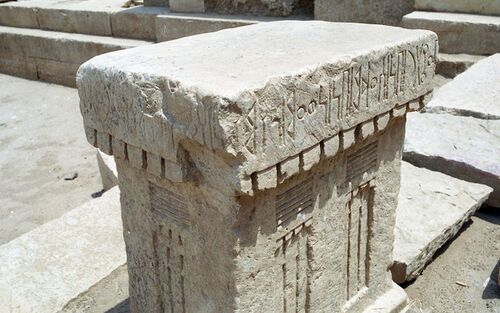
FAIR is a non-profit organization dedicated to providing well-documented answers to criticisms of the doctrine, practice, and history of The Church of Jesus Christ of Latter-day Saints.

Three altar inscriptions have been discovered containing the name "NHM" as a tribal name and dating from the seventh to sixth centuries BC. This is roughly the time period when Lehi’s family was traveling though the same area.
Nephi's party reaches an area "which was called Nahom" (1 Nephi 16:34)near the time that they make an eastward turn in their journey. [2]
It is intriguing that Nephi tells us that the deceased Ishmael was buried at a spot with a name associated with mourning and death of loved ones.
Strikingly, altars dating from the time of Lehi have been found with the inscription "NHM." [4] Semitic languages of the time did not use vowels in their written texts, so this corresponds to a name of "nahom." S. Kent Brown has addressed the linguistic issues in the NHM placename. [5]
The Semitic name Nahom can refer to mourning and consolation, and may also refer to groaning and complaining, giving it special significance in Nephi's account (see [1 Nephi 16:35.)
The NHM location has an ancient tradition of being a place for burial and mourning. Ancient tombs are still abundant in that area. The name Nehem/Nahom ("nhm"--which can also be rendered "Nihm") is a rare place name–with the only known site in the Arabian peninsula being at a place consistent with the Book of Mormon account. Thus, NHM provides archaeological evidence of a place name mentioned in the Book of Mormon at the exact place and historical period which the text requires. [6]
As one travels south-southeast of Jerusalem along the major trunk of the ancient Arabian trade route, the route branches east toward the southeastern coast at only point: in the Jawf valley (Wadi Jawf) just a few miles from Nehem. From thence the eastern branch of the trade route goes toward the ancient port of Qana--modern Bir Ali—on the Hadhramaut coast, where most of the incense was shipped. This eastern branch was the major route—the pathways to the south were less used.
<videoflash>nw7fW19Sk1A</videoflash>
In one instance, however, Nephi does preserve a local name, that of Nahom, the burial place of Ishmael, his father-in-law. Nephi writes in the passive, "the place which was called Nahom," clearly indicating that local people had already named the place. That this area lay in southern Arabia has been certified by recent Journal publications that have featured three inscribed limestone altars discovered by a German archaeological team in the ruined temple of Bar'an in Marib, Yemen.2 Here a person finds the tribal name NHM noted on all three altars, which were donated by a certain "Bicathar, son of Sawâd, son of Nawcân, the Nihmite." (In Semitic languages, one deals with consonants rather than vowels, in this case NHM.)
Such discoveries demonstrate as firmly as possible by archaeological means the existence of the tribal name NHM in that part of Arabia in the seventh and sixth centuries BC, the general dates assigned to the carving of the altars by the excavators.3 In the view of one recent commentator, the discovery of the altars amounts to "the first actual archaeological evidence for the historicity of the Book of Mormon."
Surprisingly, evidence for Nahom, the name of the place where Ishmael was buried (1 Nephi 16:34), is based on historical, geographic, and archaeological—and only secondarily on etymological—considerations.
Three altar inscriptions containing NHM as a tribal name and dating from the seventh to sixth centuries BC—roughly the time period when Lehi’s family was traveling though the area—have been discussed by S. Kent Brown.8 Dan Vogel, writing in the misleadingly named Joseph Smith: The Making of a Prophet and responding to two books by LDS authors about Lehi’s journey in the Arabian desert, has objected to the dating of the Arabian word NHM: “There is no evidence dating the [Page 158]Arabian NHM before A.D. 600, let alone 600 B.C.”9 It should be noted, however, that Burkhard Vogt, perhaps unaware of its implications for the Book of Mormon, dates an altar having the initial letters NHM(yn) to the seventh to sixth centuries BC.10 This is not insignificant since Vogel’s book was published in 2004, while Vogt’s contribution was published in 1997.Nhm appears as a place name and as a tribal name in southwestern Arabia in the pre-Islamic and early Islamic period in the Arab antiquarian al-Hamdani’s al-Iklīl11 and in his Ṣifat Jazīrat al-’Arab.12 If, as Robert Wilson observes, there is minimal movement among the tribes over time,13 the region known in early modern maps of the Arabian Peninsula as “Nehem” and “Nehhm” as well as “Nahom” may well have had that, or a similar, name in antiquity.
Biblical “minimalists” have sought to undermine or de-emphasize the significance of the Tel Dan inscription attesting to the existence of the “house of David.” Similarly, those who might be called Book of Mormon “minimalists” such as Dan Vogel have marshaled evidence to try to make the nhm inscriptions from south Arabia, corresponding to the Book of Mormon Nahom, seem as irrelevant as possible. We show why the nhm inscriptions still stand as impressive evidence for the historicity of the Book of Mormon.

FAIR is a non-profit organization dedicated to providing well-documented answers to criticisms of the doctrine, practice, and history of The Church of Jesus Christ of Latter-day Saints.
We are a volunteer organization. We invite you to give back.
Donate Now